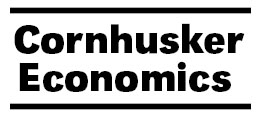Agricultural Economics, Department of

Cornhusker Economics
Date of this Version
9-24-2008
Document Type
Newsletter Issue
Citation
Cornhusker Economics
Abstract
As corn prices have more than doubled in the last two years, cattle producers continually look for alternatives to finishing calves exclusively in feedlots on high concentrate rations. Historically, Nebraska feeders have placed a high proportion of fall-weaned calves on feed in October and November and sold them as fed cattle in May. However, as corn prices increase, livestock producers have more incentive to background calves during the winter and following summer on forages, and delay placing the cattle on feed until they are long yearlings at the end of the summer grazing season.
Based on University of Nebraska–Lincoln research examining the performance of cattle in both types of systems from 1996 to 2007, the relative difference in returns to calf finishing versus yearling systems is relatively small (about $4.00/head) on average, but highly variable (Figure 1 on next page). Average returns to the calf and yearling system were $18.54/head and $14.33/head, but ranged from losses exceeding $177/head to profits above $347/head. In the ten years of the study where both systems were directly comparable, the yearling system was more profitable than calf finishing in four years and less profitable in six of the years.


Comments
Published in Cornhusker Economics, 9-24-08. Produced by the Cooperative Extension, Institute of Agriculture and Natural Resources, Department of Agricultural Economics, University of Nebraska – Lincoln. http://www.agecon.unl.edu/Cornhuskereconomics.html